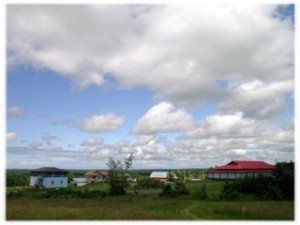Wednesday
Community Articles, Featured StoriesMeeting Hurricane Bill
By David Whitehorn
On the evening of August 21st, four people sat around a computer in the Kasung Headquarters at Dorje Denma Ling (DDL) near Tatamagouche, Nova Scotia looking at the latest internet weather reports from Environment Canada and the Canadian Hurricane Centre. The reports predicted that 36 hours later the eye of Hurricane Bill would sweep along the Atlantic coast of Nova Scotia, making landfall at Port Hawksbury, just 150 km east of DDL. At landfall Bill was predicted to be a category 2 storm with maximum sustained winds of more than 95 miles per hour. Because of the size of the hurricane, this prediction meant DDL would experience nearly the full force of the storm.
The people around the computer were the Director and Assistant Director of DDL (Pat Hayward and Tracy Lawler), the DDL Rusung (Patrick Lawler) and the Garsung of the Warrior Assembly (me, David Whitehorn). There were 97 people participanting in Warrior’s Assembly who were staying on the land, along with 20 staffers. The DDL staff, including recently arrived volunteers, numbered 20. The task was to devise an emergency response plan that would protect the well being of all of the people on the land, the DDL property and equipment (to the extent possible) and the integrity of the Warrior Assembly, due to be completed two days after the storm.
Over the next 54 hours this group developed and implemented an evolving response to the storm situation. They kept in close consultation with the Acharayas, Jeremy Hayward and Suzanne Duquette, who were leading the Warrior Assembly. The fifteen participants who made up the Warrior Assembly Dorje Kasung Squad offered their full active support.
Led by Rusung Edgar Anolin and Khenchung Lisa Stokes, during the storm the Kasung were everywhere: escorting participants to and from outlying buildings, investigating reports of damage to property, and — most of all — projecting a sense of calm, compassion, intelligence, and sense of humor. The other Warrior Assembly participants were inspired to rouse their own innate intelligence and energy by this display of Kasungship. As a result there was no panic and no complaint during the significant inconvenience and relocation required to meet the challenge of the storm. The relationship between the Kasung and the other participants was clearly demonstrated on the evening of the 23rd, as the most intense wind and rain began to subside and some participant chose to return to their outlying accommodations for the night. When Khenchung Stokes stood on a chair to be seen and heard, and announced the logistics of how the Kasung would provide escort to those going out into the elements, the participants spontaneously broke into loud and sustained applause.
At the end of the 54 hours, on the morning of August 24th, as the rain and wind subsided, with everyone on the land safe and dry, with no significant loss of property and with no break in the continuity of the Warrior Assembly practice and study, the group modestly celebrated success in relating with the elements, with the dralas of the storm.In the end, the predictions of the Canadian government 36 hours prior to the storm turned out to be a worst-case scenario. By the time the storm arrived it had taken up a more easterly course, keeping the eye several hundred kilometers off shore, and it was classified as Category 1, with maximum sustained winds over 73 miles per hour.
For those who were there, out in the storm helping protect people and property, Bill was impressive enough. Doors were literally blown off their hinges in several of the outlying structures; a serious leak developed around a large window in the main building shrine room, necessitating a very rapid change in the location of the shrine; several sections of the canvas wall of the Pavilion structure (used as the shrine room for the Warrior Assembly, but fully evacuated during the storm) were blown in. The sensation of rain being driven against ones face by 60 mile per hour gusts of wind is memorable.
As this is being written, final preparations are happening for two very large gatherings at Dorje Denma Ling in September, the Rigden Abhisheka and the Scorpion Seal Assembly. The lessons learned from working with Hurricane Bill will be available if an intense weather system approaches during those events. Two lessons seem worth noting. The first lesson is the critical importance of careful planning days ahead of the storm, involving all the key leaders in the mandala, and the ongoing adjustment of the plan to match the ever changing conditions. The second lesson is to recognize how fortunate we are in our Shambhala gatherings to have the Dorje Kasung available to manifest their organizational and personal training in order to protect the mandala at all levels in the face of extreme conditions.
 _____________________________________________
_____________________________________________
David Whitehorn (Mountain Drum) has been a student of the Sakyongs since 1971. Since then he has served in a number of administrative and teaching roles in the Vajradhatu / Shambhala mandala. Currently he is the chair person for the Shambhala Working Group on Aging and a member of the Sakyong’s Council. He is also an active member in the Dorje Kasung, holding the rank of Rupon, and is a senior officer in the Desung Arm. He lives in Halifax and is semi-retired, having worked for many years as a psychiatric clinical nurse specialist.


















